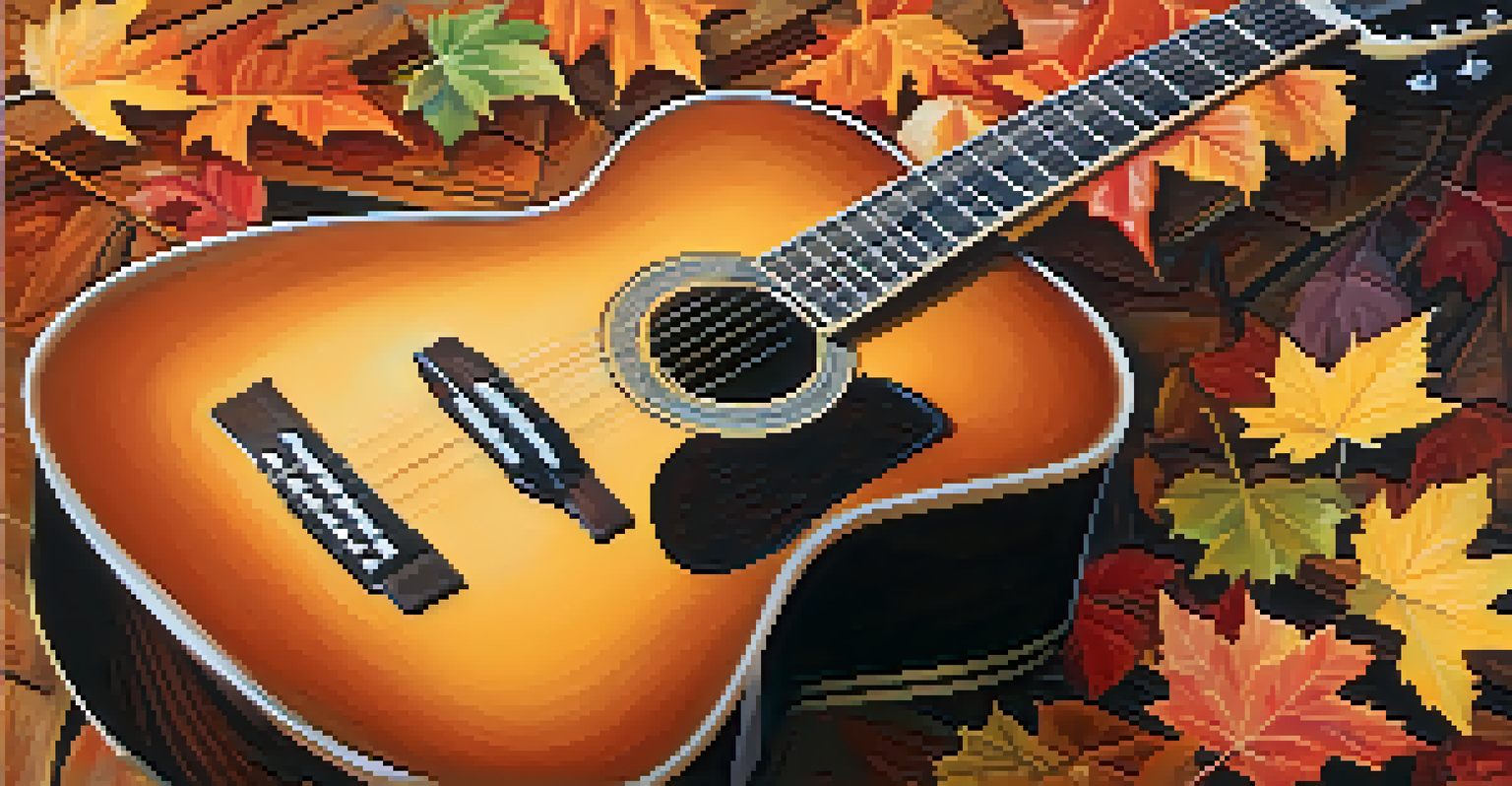The Influence of Folk Music on the Acoustic Guitar's Journey

The Roots of Folk Music and Acoustic Instruments
Folk music has deep roots that intertwine with the history of acoustic instruments, including the guitar. Originating from oral traditions, folk music reflects the stories and experiences of everyday people. The acoustic guitar, with its warm tones and portability, became the perfect companion for these storytellers, bringing melodies to life in villages and gatherings.
Music can change the world because it can change people.
In many cultures, the guitar serves as a focal point for community and connection, allowing musicians to share their heritage. For instance, the Spanish flamenco guitar and the American folk guitar both showcase how regional sounds influence acoustic playing styles. This cross-cultural exchange helped shape the acoustic guitar into a versatile instrument embraced by various genres.
As folk music evolved, so did the acoustic guitar, adapting to the changing musical landscapes. It became a staple in family gatherings, campfires, and social movements, embodying a spirit of unity and resistance. The acoustic guitar is not just an instrument; it is a vessel for cultural expression and storytelling.
Folk Music's Influence on Acoustic Guitar Techniques
The techniques used in folk music have significantly influenced acoustic guitar playing. Fingerpicking, strumming patterns, and slide guitar techniques all find their roots in folk traditions. These methods allow for a rich texture and emotional depth, making each performance unique and personal.

For example, fingerpicking allows guitarists to create intricate melodies while maintaining a steady rhythm, a hallmark of many folk songs. Artists like Woody Guthrie and Joan Baez popularized these techniques, showcasing how a simple guitar could carry powerful narratives. Their styles inspired countless musicians to explore the acoustic guitar's capabilities beyond mere accompaniment.
Folk Music's Cultural Significance
Folk music serves as a powerful vehicle for storytelling and cultural exchange, with the acoustic guitar playing a central role in connecting communities.
Additionally, improvisation plays a crucial role in folk music, encouraging players to develop their own styles. This freedom has led to the emergence of various sub-genres, each with its distinct flavor. As guitarists draw from folk influences, they continue to innovate, creating a dynamic and evolving acoustic guitar landscape.
The Role of Acoustic Guitar in Folk Music Revival
The folk music revival of the 1960s marked a significant moment for the acoustic guitar. During this time, artists like Bob Dylan and Pete Seeger brought the acoustic guitar to the forefront of popular music, intertwining it with social and political movements. Their music resonated with the youth, amplifying messages of change and unity.
The guitar is a miniature orchestra in itself.
This revival not only revitalized interest in traditional folk music but also showcased the acoustic guitar's versatility. The guitar became a symbol of protest and hope, as it was carried into rallies and gatherings. As a result, many young musicians picked up the instrument, eager to express their own beliefs and experiences through music.
Moreover, the revival sparked a renewed appreciation for craftsmanship in acoustic guitars. Luthiers began to experiment with designs and materials, resulting in a diverse range of instruments that catered to the needs of folk musicians. This period solidified the acoustic guitar's place in both folk music and broader musical contexts.
Cultural Exchange Through Folk Music and Guitar
Folk music and the acoustic guitar have always been vehicles for cultural exchange. As musicians travel and share their music, they introduce new styles and techniques, enriching the folk music tradition. This blending of cultures is evident in genres like bluegrass, which incorporates elements of African, Irish, and Spanish music.
Acoustic guitarists often adapt their playing to reflect the diverse influences they encounter, creating a unique sound that resonates with a wide audience. For instance, the incorporation of Latin rhythms into folk songs has led to a vibrant fusion that continues to evolve today. This cultural exchange helps maintain the relevance of folk music in contemporary society.
Techniques Shaping Acoustic Guitar
The techniques derived from folk music, such as fingerpicking and improvisation, have significantly influenced acoustic guitar playing and innovation.
Additionally, festivals and gatherings dedicated to folk music provide platforms for these exchanges. Musicians from different backgrounds come together to share their craft, fostering a sense of community. Through these interactions, the acoustic guitar remains a powerful tool for storytelling and connection across cultures.
Modern Folk Musicians and Acoustic Guitar Innovations
Today's folk musicians continue to push the boundaries of acoustic guitar playing, blending traditional techniques with modern influences. Artists like Brandi Carlile and The Lumineers are redefining folk music while maintaining its roots. Their innovative approaches showcase the guitar's adaptability in contemporary music scenes.
Many modern musicians are experimenting with new tunings and effects, expanding the sonic possibilities of the acoustic guitar. By incorporating elements from genres like rock and pop, they create a fresh sound that appeals to a broader audience. This evolution demonstrates how the acoustic guitar remains relevant in a rapidly changing musical landscape.
Moreover, the rise of social media has allowed these musicians to reach global audiences. Platforms like YouTube and Instagram enable them to share their unique styles and techniques, inspiring others to explore the acoustic guitar. As modern folk musicians continue to innovate, they ensure the acoustic guitar's legacy lives on.
The Influence of Folk Music on Acoustic Guitar Genres
Folk music has laid the groundwork for numerous acoustic guitar genres, each reflecting its cultural origins. From bluegrass to country, these genres showcase the guitar's versatility and adaptability. The acoustic guitar serves as a common thread, connecting diverse musical styles that have emerged from folk traditions.
For instance, bluegrass emphasizes fast-paced picking and intricate harmonies, while country music often features storytelling lyrics and melodic strumming patterns. Both genres have roots in folk music, highlighting how these traditions continue to influence contemporary guitar playing. The acoustic guitar remains a fundamental instrument in these genres, bridging the gap between the past and the present.
Modern Innovations in Folk Music
Today's folk musicians blend traditional acoustic guitar techniques with modern influences, ensuring the instrument's continued relevance in contemporary music.
As new genres emerge, the influence of folk music persists, inspiring guitarists to explore their heritage. Musicians often draw on folk elements to create fresh sounds, ensuring the acoustic guitar remains a vital part of the evolving music landscape. This interplay between tradition and innovation keeps the acoustic guitar relevant across generations.
Conclusion: The Enduring Legacy of Folk Music on the Acoustic Guitar
The relationship between folk music and the acoustic guitar is a testament to the power of cultural expression. As folk music has evolved, so too has the acoustic guitar, adapting to new influences and techniques. This synergy has created a rich tapestry of musical traditions that continue to resonate with audiences today.
The acoustic guitar's role in folk music has not only shaped its sound but also its significance as a tool for storytelling and connection. Through every strum and pluck, musicians convey their experiences, bridging gaps between cultures and generations. This enduring legacy speaks to the guitar's ability to unite us through shared narratives.

As we look to the future, the influence of folk music on the acoustic guitar remains strong. New generations of musicians will undoubtedly continue to draw inspiration from this rich heritage, ensuring that the acoustic guitar remains a beloved instrument for years to come. The journey of the acoustic guitar, intertwined with folk music, is a story that is far from over.